Tam Chuc Pagoda, a precious gem of Ha Nam province, is not only the largest pagoda in Vietnam but also a spiritual destination attracting visitors from all directions with its majestic, poetic beauty and profound cultural and historical values. Are you planning to explore this “Halong Bay on land”? This article by Discovery Wonders will provide you with the most detailed guide to help you have a fulfilling and meaningful journey at Tam Chuc Pagoda.
Overview of Tam Chuc Pagoda
Location and Scale
Tam Chuc Pagoda is located in Ba Sao town, Kha Phong commune, Kim Bang district, Ha Nam province. Situated about 70km south of Hanoi city center and 10km from Phu Ly city, the pagoda boasts a prime “leaning on mountains, facing water” location. The Tam Chuc pagoda complex covers an area of up to 5000ha, including lakes, natural rocky mountains, and lush green valleys.
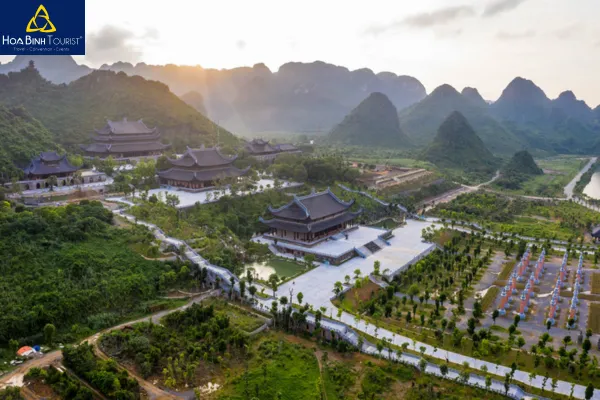
History of Formation
Tam Chuc Pagoda has a history dating back to the Dinh Dynasty, over 1000 years ago. Legend has it that in ancient times, 7 stars (That Tinh) appeared on 7 mountains, representing 7 fairies descending to earth, captivated by the beauty of this place. Being engrossed, they forgot their way back. Heaven then sent someone to bring bells down to call them 6 times but in vain. The 6 small islands rising in the middle of the lake are the 6 heavenly bells, and the 7 mountains are That Tinh (Seven Stars). The pagoda on That Tinh mountain has since been named Ba Sao Pagoda, and Ba Sao town was also born from it.
Today, Tam Chuc Pagoda is not only famous for its scale but also the place chosen by the Vietnam Buddhist Sangha to host the United Nations Vesak Day 2019. The pagoda worships national masters who made great contributions to the development of Vietnamese Buddhism such as Zen Master Bodhidharma, Zen Master Khuong Viet, Zen Master Do Phap Thuan, Zen Master Nguyen Minh Khong, and Venerable Thich Thanh Tu.
Unique Architecture of Tam Chuc Pagoda
The architecture of Tam Chuc Pagoda is a harmonious combination of traditional beauty and modern sophistication. Prominent structures in the pagoda complex include:
Ngoc Pagoda (Altar of Heaven)
Located on the peak of That Tinh Mountain, at an altitude of 200m above sea level, Ngoc Pagoda appears majestic and magnificent. The pagoda is built entirely of red granite, with a height of 15m and a weight of 2000 tons. To reach the pagoda, visitors must climb 299 steps. Inside the pagoda, there is a ruby Amitabha Buddha statue weighing 4.9 tons and a white jade Guanyin statue weighing 5kg, all of which are priceless treasures.
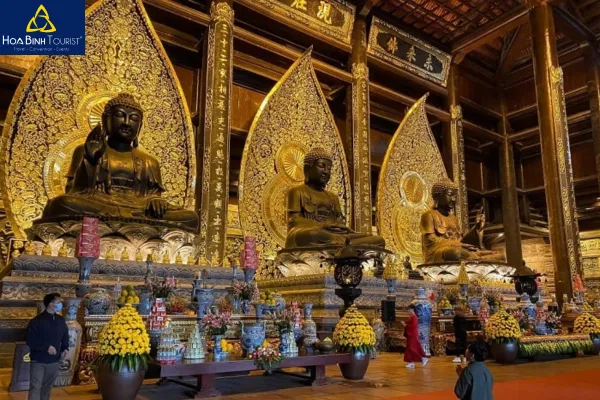
Tam The Palace (Palace of the Three Times)
Tam The Palace is one of the largest and most important structures of Tam Chuc Pagoda. The palace has a 3-tiered curved roof architecture, imbued with Vietnamese tradition, with a capacity of up to 5000 Buddhists. Inside the palace, three bronze Tam The statues are worshiped, each weighing 200 tons, representing the past, present, and future. The walls of the palace are decorated with reliefs depicting Buddhist philosophical stories.
Phap Chu Palace (Dharma Master Palace)
Located below Tam The Palace, Phap Chu Palace stands out with a monolithic bronze statue of Shakyamuni Buddha weighing 150 tons. Four large reliefs surrounding the palace walls depict important stages in the life of the Buddha, from birth to Nirvana.
Tam Quan Gate (Three-Entrance Gate)
The Tam Quan Gate of Tam Chuc Pagoda symbolizes the “Three Gates” in Buddhism, including the gate of existence, the gate of emptiness, and the gate of the middle way. The gate has 3 entrances, with the main gate in the middle and two side gates on either side. The floor area of the gate is 3558m2 and the height is 28.8m.
Quan Am Palace (Avalokiteśvara Bodhisattva Palace)
Quan Am Palace is where Avalokiteśvara Bodhisattva is worshiped, with reliefs showing the compassion and equanimity of the Buddha. These reliefs are made of Merapi volcanic stone (Indonesia) by Javanese artisans, accompanied by annotations in Vietnamese, English, and Sanskrit.
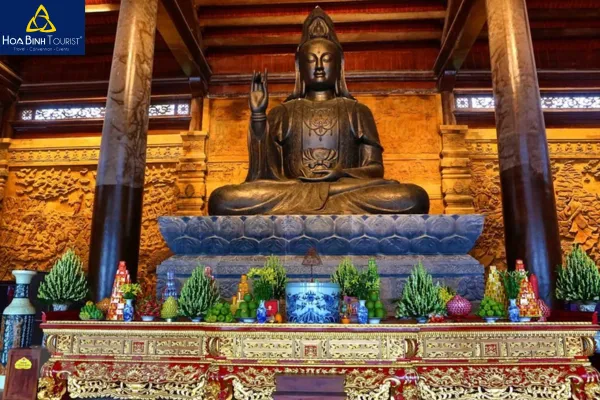
Kinh Pillars Garden (Sutra Pillars Garden)
From Tam Quan Gate to Quan Am Palace, visitors will pass through the Kinh Pillars Garden, where there are 32 Buddhist sutra pillars restored based on the model of the sutra pillars at Nhat Tru Pagoda (Ninh Binh). Each pillar weighs about 200 tons, is made of Thanh Hoa green stone, and engraved with the teachings of the Buddha.
International Conference Center (Thuy Dinh Guest House)
The International Conference Center, also known as Thuy Dinh Guest House, is located on the lake surface, with a unique architecture like a blooming lotus flower. The interior is decorated solemnly, with LED light paintings introducing Tam Chuc Pagoda.
Tam Chuc Communal House (Dinh Tam Chuc)
Tam Chuc Communal House worships Queen Duong Thi Nguyet of the Dinh Dynasty, connected to Tam Chuc Pagoda by a bridge across Luc Ngan Lake. According to legend, before Dinh Bo Linh quelled the rebellion of the 12 warlords, he came here to recruit soldiers.
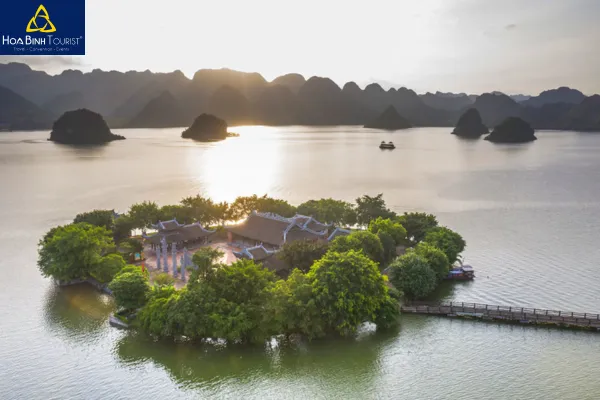
Entrance Fees and Transportation
Currently, Tam Chuc Pagoda does not charge entrance fees. However, visitors need to buy electric car or boat tickets to visit:
- Electric car: 90,000 VND/round trip ticket/person.
- Boat: 200,000 – 350,000 VND/person.
Tam Chuc Pagoda Travel Experience
Ideal Time to Visit
You can visit Tam Chuc Pagoda at any time of the year, as each season the pagoda has its own beauty. However:
- January – March: Cool weather, suitable for spring travel, praying for peace.
- April – July: Hot weather, need to prepare sunscreen carefully.
- October – December: Quiet, suitable for those who want to find peace.
In particular, you should visit the pagoda during important Buddhist holidays such as Buddha’s Birthday (April 15th lunar calendar), Vu Lan Festival (July 15th lunar calendar), Mid-Autumn Festival (August 15th lunar calendar), and Buddha’s Enlightenment Day (December 8th lunar calendar).
Transportation to Tam Chuc Pagoda
- Motorbike, car: Follow Giai Phong road -> Thuong Tin – Phu Xuyen -> QL1A -> Phu Ly -> QL21 -> Tam Chuc Pagoda.
- Bus: Take a bus at Giap Bat, Nuoc Ngam, or Yen Nghia bus station to Phu Ly (ticket price about 50,000 VND/person). Then, take a taxi or motorbike taxi to Tam Chuc Pagoda.
- Airplane: If you are far away, you can fly to Hanoi, then travel by bus, taxi, or motorbike to Tam Chuc Pagoda.
Offerings for Temple Visit
When visiting Tam Chuc Pagoda, you should prepare vegetarian offerings such as incense, fresh flowers, fruits, oản (glutinous rice cakes), and sweet sticky rice. Avoid preparing savory offerings such as pork, chicken, and Vietnamese sausage. Buy offerings at home to avoid being “ripped off” during festivals.
What to Eat at Tam Chuc Pagoda?
When coming to Ha Nam, don’t forget to enjoy the following famous specialties:
- Phu Ly grilled pork sausage and steamed rolled rice pancake (Banh cuon cha nuong Phu Ly): A typical dish of Ha Nam.
- Vu Dai clay pot braised fish (Ca kho nieu dat Vu Dai): A flavorful traditional braised fish dish.
- Dai Hoang royal banana (Chuoi ngu Dai Hoang): A precious banana variety offered to kings.
- Vegetarian dishes: Enjoy pure vegetarian dishes in the pagoda space.
- Tam Chuc mud carp (Ca doi Tam Chuc): Delicious mud carp specialty of Tam Chuc lake.
- Binh Luc fermented crab paste (Mam cay Binh Luc): Flavorful fermented crab paste of the countryside.
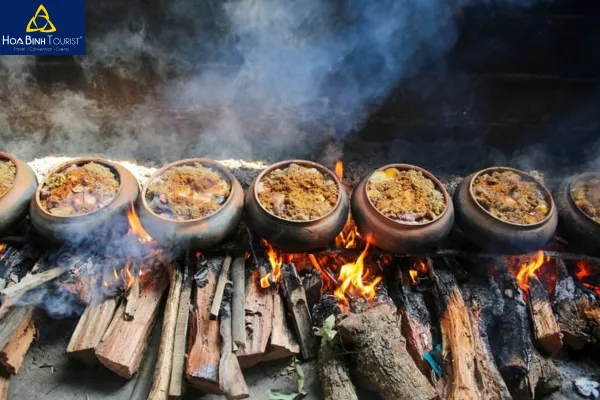
Important Notes
- Dress modestly and respectfully when entering the pagoda.
- Wear comfortable shoes as you have to walk a lot.
- Prepare hats, and sunscreen if going in the summer.
- Maintain general hygiene, do not litter indiscriminately.
- Be careful with personal belongings, avoid pickpocketing.
- You should learn about the history and architecture of the pagoda beforehand to make your visit more meaningful.
- If you have time, you can combine visiting other famous tourist attractions in Ha Nam such as Huong Pagoda, Ba Danh Pagoda, Hoa Lu ancient capital, Tam Coc – Bich Dong.
Conclusion
Hopefully, with the detailed information above, you will have a truly fulfilling and meaningful visit to Tam Chuc Pagoda. Tam Chuc Pagoda is not only a spiritual destination but also an architectural masterpiece, a unique cultural space where you can find peace in your soul and explore the profound historical and cultural values of the nation. Are you ready for a journey to discover this “Halong Bay on land”? Please share your experiences after your trip!